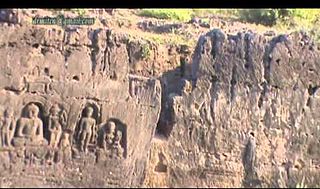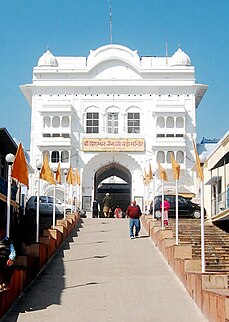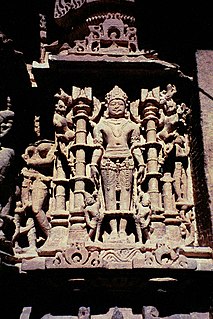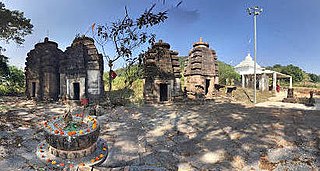| Aluara bronzes | |
|---|---|
| Year | 11th century |
| Medium | Bronze |
| Part of a series on |
| Jainism |
|---|
 |
The Aluara Bronzes or Aluara Hoard represent a rare and important set of Jain images found in Aluara near Dhanbad region of Bihar, in Eastern India.
| Aluara bronzes | |
|---|---|
| Year | 11th century |
| Medium | Bronze |
| Part of a series on |
| Jainism |
|---|
 |
The Aluara Bronzes or Aluara Hoard represent a rare and important set of Jain images found in Aluara near Dhanbad region of Bihar, in Eastern India.
These bronze images dedicated to Jain tirthankaras that dates back to 11th century. They are currently kept in Patna Museum for preservation. [1]
The idol of Kunthunatha, the 17th tirthankara was found in padmasan posture with symbol of goat punched into the simhasan (pedestal). [1]
The image of Ambika, the protector goddess of the 22nd tirthankara, Neminatha, standing in tri-bhanga posture with her two sons and lion mount. [2]
Other well-known hoards of Jain bronzes include Akota Bronzes, found in Gujarat; Vasantgarh hoard, found in Vasantgarh; Hansi hoard, found in Haryana; and Chausa hoard, found in Bihar.

The Śvētāmbara is one of the two main branches of Jainism, the other being the Digambara. Śvētāmbara means "white-clad", and refers to its ascetics' practice of wearing white clothes, which sets it apart from the Digambara "sky-clad" Jains, whose ascetic practitioners go naked. Śvētāmbaras, unlike Digambaras, do not believe that ascetics must practice nudity.

In Jainism, a Tirthankara is a saviour and spiritual teacher of the dharma. The word tirthankara signifies the founder of a tirtha, which is a fordable passage across the sea of interminable births and deaths, the saṃsāra. According to Jains, a Tirthankara is an individual who has conquered the saṃsāra, the cycle of death and rebirth, on their own, and made a path for others to follow. After understanding the true nature of the self or soul, the Tīrthaṅkara attains Kevala Jnana (omniscience). Tirthankara provides a bridge for others to follow the new teacher from saṃsāra to moksha (liberation).

Padmāvatī is the protective goddess or śāsana devī (शासनदेवी) of Pārśvanātha, the twenty-third Jain tīrthāṅkara, complimenting Parshwa yaksha, the shasan deva. She is a yakshi of Parshwanatha.

This was the first known bronze hoard discovered in the Gangetic valley and consists of a set of 18 Jain bronzes. The Chausa hoard, thus named after the place of discovery: Chausa or Chausagarh is located in the Buxar district of Bihar state, India.

Suparshvanatha, also known as Suparśva, was the seventh Jain Tīrthankara of the present age (avasarpini). He was born to King Pratistha and Queen Prithvi at Varanasi on 12 Jestha Shukla in the Ikshvaku clan. He is said to have attained moksha at Shikharji on the sixth day of the dark half of the month of Phālguna.

Neminatha, also known as Nemi and Arishtanemi, is the twenty-second tirthankara (ford-maker) in Jainism. Along with Mahavira, Parshvanatha and Rishabhanatha, Neminatha is one of the twenty four tirthankaras who attract the most devotional worship among the Jains.

In Jainism, Ambika or Ambika Devi is the Yakṣi "dedicated attendant deity" or Śāsana Devī "protector goddess" of the 22nd Tirthankara, Neminatha. She is also known as Ambai, Amba, Kushmandini and Amra Kushmandini. She is often shown with one or more children and often under a tree. She is frequently represented as a pair with a small Tirthankar image on the top. The name ambika literally means mother, hence she is Mother Goddess. The name is also a common epithet of Hindu Goddess Parvati.

Jain sculptures or Jain idols are the images depicting Tirthankaras. These images are worshiped by the followers of Jainism. The sculpture can depict any of the twenty-fourtirthankaras with images depicting Parshvanatha, Rishabhanatha, or Mahāvīra being more popular. Jain sculptures are an example of Jain art. There is a long history of construction of Jain sculptures. Early examples include Lohanipur Torsos which has been regarded to be from the Maurya period, and images from the Kushan period from Mathura.

Jain art refers to religious works of art associated with Jainism. Even though Jainism has spread only in some parts of India, it has made a significant contribution to Indian art and architecture.

The Dhank Caves are located near Dhank village near Upleta, Rajkot district, Gujarat, India. They were chiseled out of a calcareous sandstone outcropping during the regime of the Western Satraps. The caves are influenced by Buddhist and Jain cultures. The Jain cave includes figures of Adinath, Shantinath and Pārśva. These are considered to be the earliest Jain sculptures in Kathiawad.

The Akota Bronzes represent a rare and important set of 68 Jain images, dating to between the 6th and 12th centuries AD, which were found in the vicinity of Akota near Baroda in the Indian state of Gujarat. It includes rare Gupta period bronzes that have been widely used for comparison of Gupta period art.

Shri Digamber Jain Prachin Bada Mandir is a Jain temple complex in located in Hastinapur, Uttar Pradesh. It is the oldest Jain temple in Hastinapur dedicated to Shri Shantinatha, the 16th Jain Tirthankara.

Jivantasvami images represent the Jain Tirthankara Mahavira as a prince, with a crown and ornaments. The Jina is represented as standing in the kayotsarga pose. Jivantasvami images have been used only in the Shvetambara Jain tradition, they are unknown in the Digambara tradition.

The Lohanipur torso is a damaged statue of polished sandstone, dated to the 3rd century BCE ~ 2nd century CE, found in Lohanipur village, a central Division of Patna, ancient Pataliputra, Bihar, India. There are some claims however for a later date, as well as of Graeco-Roman influence in the sculpting.The Lohanipur torso is thought to represent a Jaina Tirthankara.
The Hansi hoard was discovered accidentally by children looking for a ball, when they discovered one of the images on January 19, 1982. Hansi is located in the Hisar district of Haryana state, India. Archaeological Survey of India then excavated the completely hoard in 1982. It contained 58 bronze images of Jain Tirthankaras inside Asigarh Fort dating back to the 8th-9th century, as determined by paleographical analysis, although none of the images are dated.
In 1956, 240 Jain bronze idols were discovered dating back to early medieval to medieval period. The Vasantgarh hoard, thus named after the place of discovery, Vasantgarh is located in the Sirohi District of Rajasthan, India.

In Jain cosmology, Gomukha is the guardian god or Yaksha of Rishabhanatha, the first Tirthankara.

Kere Basadi or Chaturmukha Basadi is a Jain temple located in Varanga village in Udupi district of Karnataka, India. This 12th-century temple is situated amidst of a lake giving it the name Kere Basadi. The temple is also known Chaturmukha Basadi as it houses a chaturmukha (four-faced) idol of tirthankaras. The temple is situated 26 km from Karkala, another popular Jain centre.

Subai Jain temples is a group of Jain temple in Subai village of Koraput district, Odisha.

Pakbirra Jain temples is a group three Jain temples in Pakbirra village in Purulia district of West Bengal.